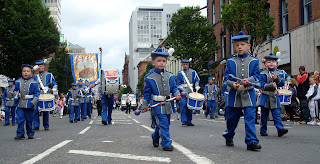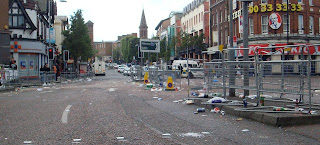
Until this week, I wasn’t aware that the Twelfth would have been commemorated on the first of July (Battle of Boyne = 1 July 1690 Julian calendar) if it hadn’t been for the British adoption of Pope Gregory’s shifting of the calendar in 1752!
But then I also wasn’t aware that the Pope had given a mass to celebrate William of Orange’s victory at the Boyne. Something that wasn’t mentioned on the banners or in the field this afternoon – though they were strong on Freedom and Liberty ...
A year later in July 1691, the Battle of Aughrim – my old house at school – was won by a battlefield fluke when the Jacobite general (who was winning at the time) was unexpectedly decapitated by an even more unexpected cannon ball, throwing the Jacobite forces into disarray and allowing the Williamites to take advantage of the panic.
As regular readers will have realised, AiB doesn’t offer much comment on politics. But we’ve been on a bit of a cultural tour this weekend with about 20 others. (Happy Birthday mapgirl!) A run through Irish history before taking in the bonfire at Pitt Park and then moving onto the huge East Belfast blaze at King George V Park beside the Oval. And the next morning, a briefing on the Orange Order, the history of the Twelfth parades, and the particulars of the Belfast one.

Dress ...
Perched on a traffic island in Bedford Street there seemed to be few references to the mostly European troops that fought at the Boyne and at Aughrim. Though along with Lord Laird’s slightly-surreal float and its military models, there were a lot of old uniforms and flags from the period around the Somme being worn and waved as the parade moved through the streets.
From brief memories of a parade in Lisburn some 25 or more years ago, the Orangemen’s dress was a lot less formal. Young folk paraded – even carrying banners – in jeans and ordinary tops. If you were over 25, suit and tie did seem to be the order of the day. But few bowlers hats, and even fewer black umbrellas.

In contrast, the band uniforms are particularly smart, again drawing on older military dress to back up the legacy UVF flags that are often being carried. But the look felt more sinister than historic.
There were even a couple of women’s lodges joining the main twelfth parade, which used to be an all male affair.
Musicality ...
Apparently the Belfast County parade is too long for pipers, so pipe bands tend to save their breath for the shorter country marches. Belfast is the poorer as a result. No pipes. No silver bands. Just flutes and drums, drums and flutes, and a couple of accordion bands.

Turns out that lodges have to hire in the band that marches in front of them. In many cases, that means that the 15-30 men are paying out £2000+ to employ a band with 40 or more players for the day. Even more expensive if they need to travel across from Scotland. An expensive business to keep up appearances in the main parade.
It is old but it is beautiful, and its colours they are fine
It was worn at Derry, Aughrim, Enniskillen and the Boyne.
My father wore it as a youth in bygone days of yore,
And on the Twelfth I love to wear the sash my father wore.
The Sash – which wasn’t in fact worn at Aughrim or the Boyne, as the Orange Order didn’t exist until 1795 – could only be heard twice from our vantage point. Twice during a two and a half hour parade. So while the bands may have lacked instrument variety, they had a wide range of tunes at their disposal to stop constantly reverting back to the best known loyalist ditty.
Deportment ...
There was a lot less alcohol under the deck chairs that lined the route than I expected. And where we were standing, very little sign of underage drinking. (A different story up at the field.) So perhaps the Orange Order’s requests for an alcohol-light parade – in keeping with their desire to re-brand the march and its surrounding events as Orangefest – had been heeded. While I heard stories about the police getting spectators to empty out their alcohol into the drain, I didn’t see it happen. But there was certainly no sign of any Orange marshals interacting with the crowd.

Maybe next year the Orange Order will move on to a zero-tolerance litter campaign. The rubbish and glass bottles strewn across the pavements and roads, particularly in the busy areas from Shaftsbury Square onwards (well away from the BBC’s cameras at Bedford Street) was phenomenal.

So the criminal offences around alcohol weren’t the only ones on hold for the day. Valid vehicle licence plates didn’t seem essential to drive on the roads. (Unless every lodge has really bought and registered plates starting LOL ___?) But sticking the lodge number over your normal number plates (front and back) or wrapping a plastic bag around them (perhaps to disguise the number) was the order of the day.
Later on that afternoon, driving back along the dual carriageway at Knockbreda, lots of the cars were driving back home along the road, still using their LOL plates.
Reflecting back on the Belfast parade, I suspect the Orange Order has some way to go before the march will be truly accessible to those outside the institution, its politics and its traditions. The youth and size of the bands is in stark contrast to the growing age and decreasing size of the lodges.
And the Orange Order’s slowness to modernise isn’t going to help secure its future. Having launched their Diamond Dan superhero, why didn’t he make an appearance at the flagship Belfast County parade. What would it have taken to pay for someone to knock up a costume or ten, and plant Disney-like characters up and down the parade route to reach out to the youngsters sitting on the pavements of Belfast.
A lack of imagination – or an unwillingness to change?
There'll be another post about the field, a plenty of pictures over on Flickr.
5 comments:
In the seventies we (grannies,uncles, aunts, cousins, parents...) all used to congregate at my relatives' home on Maryville Park; we walked down to the Lisburn Road and all watched the parade. Really festive occasion. It fizzled out when Granny died.
Tim
Why the big deal about the litter? Go to any festival in the world and you will find litter.
At a music festival in Scotland at the weekend their was 67 arrests, multiple stabbings, one resulting in death so im sure we can put up with a bit of litter (which is cleaned up vert quickly by the council)
> Why the big deal about the litter?
> Go to any festival in the world
> and you will find litter.
True. and if it was just the odd bit of litter that would overlooked.
But it's the volume of litter. Folk bringing bags of food and beer and BBQs with them, and then just leving them behind. They came in a bag, but didn't go home - or to a bin - in a bag.
And it's the attitude. Interviewed on the radio (Nolan, Fri 11th) and asked about the Orange Order's responsibility to help clear up, the answer was very defensive. No. We pay rates.
Not - give us a break, we've put out a strong message about on-street drinking this year, and next year we'll tackle litter. (And the level of on-street drinking seemed a lot lower than I expected this year - so looks like their approach worked.)
Nor was it, well we recognise that a huge successful festival like ours will put extra pressure on the Council cleansing department so we voluntarily make a small donation to show that we care ... and in future years we hope that people will reduce the burden of clearing up.
Or we've got a team of twenty marshals handing out bin bags to folk sitting along the sides of the road so that the Council only have to lift the bags and not the rubbish.
But no - we pay rates, so it's our right to be cleared up after. For an organisation that talks so much about taking responsibility, strong leadership and it's protestant heritage, it felt like a pathetic answer and one that didn't leave the streets "looking a bit protestant" - if I can use an old phrase that might be starting to wear thin!
The entry about the Julian calendar is wrong. July 12 1690 was actually, July 12 1690 under the Julian calendar. That would be because the Julian calendar was being used then. In other words, we can't recalculate the date as if the Gregorian calendar had been in use then, as it wasn't.
Had 12th July 1690 been a Gregorian date, it would have converted to the 2nd July in the Julian calendar.
The date of the 12th this year was I think the 29th of June in the Julian calendar. The calendars drift apart very gradually because century years (1900, 2000) are leap years in the Julian and not in the Gregorian calendar - this was the reason for moving calendar, because the Julian had drifted off from solar accuracy owing to the inaccurate calculation of the length of the earth's orbit of the sun (today, the 19th, is the 6th).
As far as I always knew, the reason for marching on the 1st is to commemmorate the Battle of the Somme (1st July 1916).
i had always thought that the battle of aughrim was fought on the 12th july 1691 and the boyne on the 1st july 1690 (coincidentally the same day and month as the first day of the somme offensive).
http://en.wikipedia.org/wiki/Battle_of_the_Boyne
http://en.wikipedia.org/wiki/Battle_of_Aughrim
Post a Comment